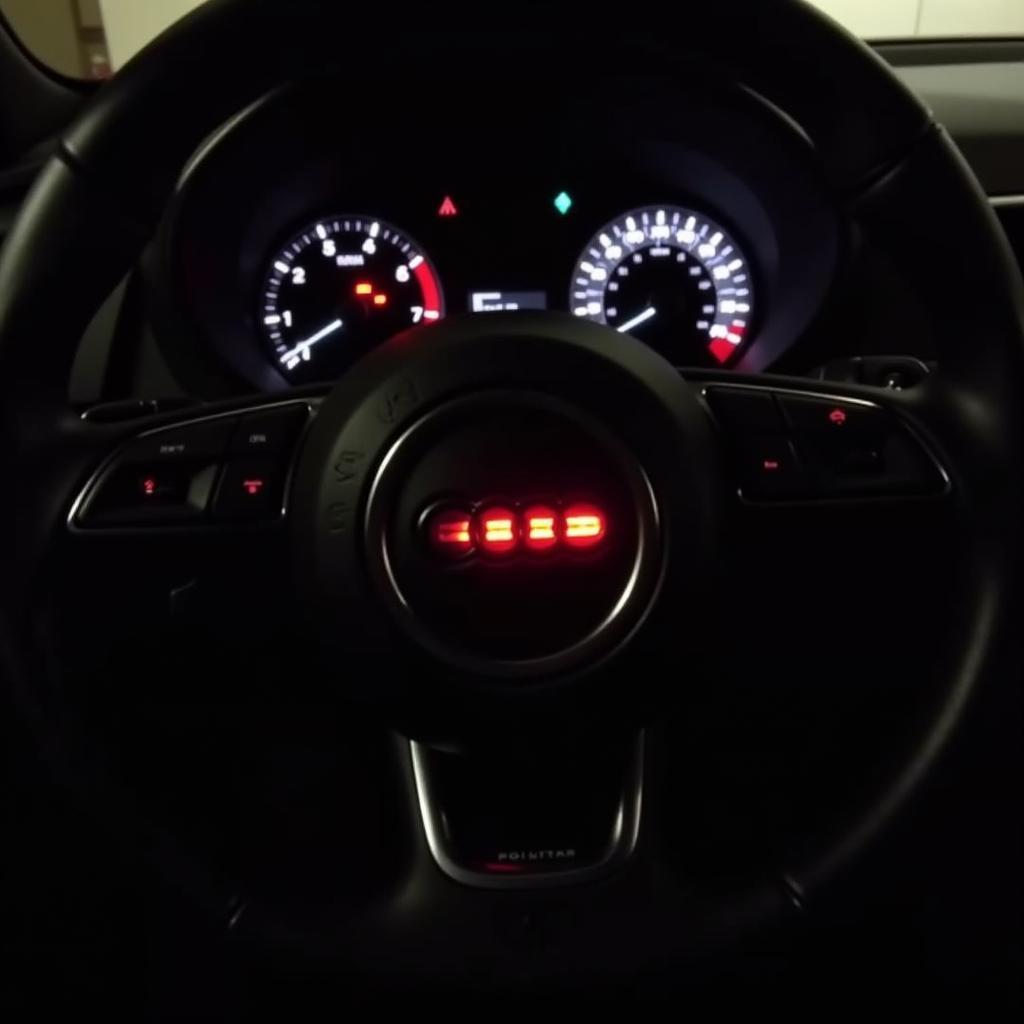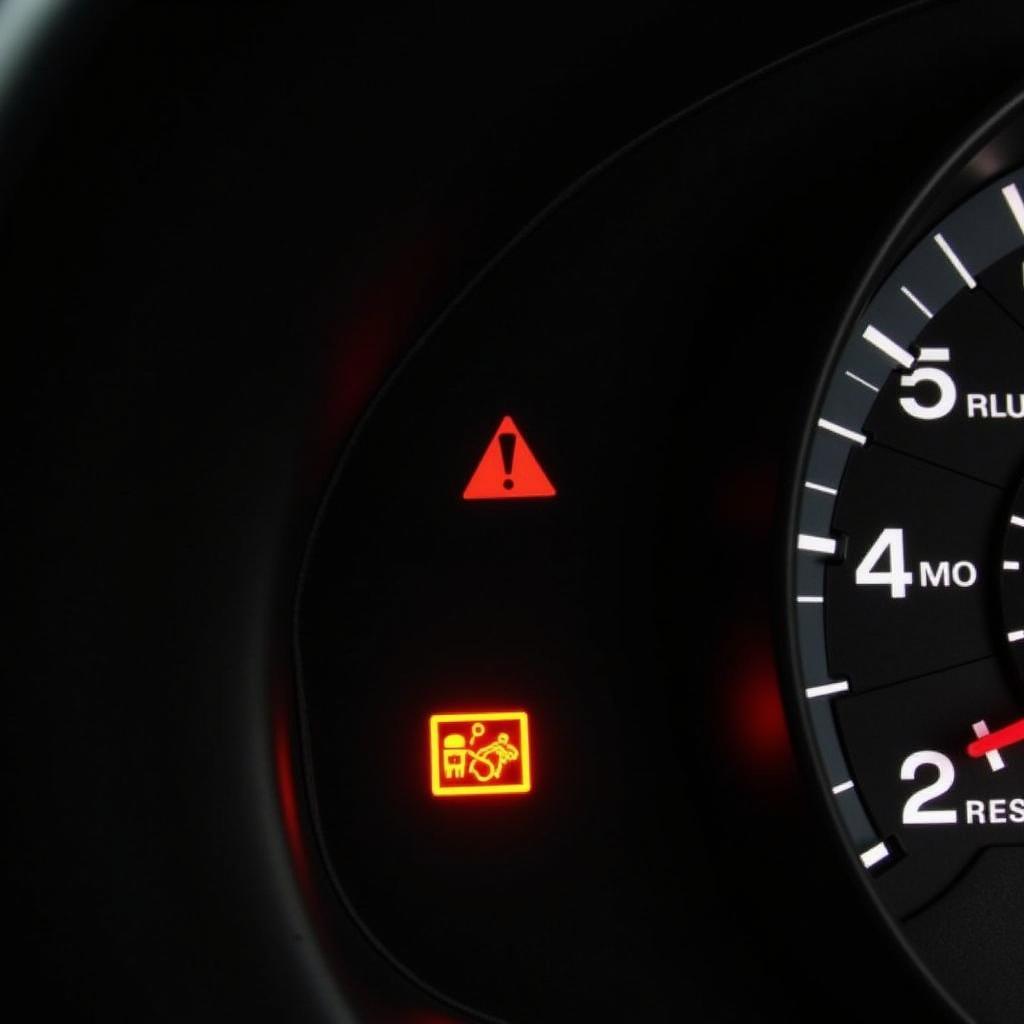The Audi TT is a renowned sports car known for its performance and sleek design. However, even the most reliable vehicles can encounter issues. One common problem Audi TT owners may face is the dreaded brake light warning. This warning light, often accompanied by a message on the dashboard, indicates a fault within the braking system that requires immediate attention.
This comprehensive guide delves into the common causes behind the Audi TT brake light warning and provides potential solutions to help you get back on the road safely.
Understanding the Audi TT Brake Light Warning System
Your Audi TT’s brake light warning system is a crucial safety feature designed to alert you of potential problems within the braking system. The system uses various sensors to monitor different components and triggers the warning light when it detects an anomaly.
 Audi TT brake warning light on dashboard
Audi TT brake warning light on dashboard
Common Causes of an Audi TT Brake Light Warning
Several factors can trigger the brake light warning on your Audi TT. Here are some of the most common culprits:
- Worn Brake Pads: Brake pads are designed to wear down over time. When they become too thin, the brake pad wear sensor will make contact with the brake rotor, triggering the warning light.
- Faulty Brake Light Switch: The brake light switch, located under the brake pedal, is responsible for activating the brake lights when you press the pedal. A malfunctioning switch can cause the brake lights to stay on constantly, flicker intermittently, or not illuminate at all.
- Brake Fluid Leak: Brake fluid is essential for transferring hydraulic pressure from the master cylinder to the brake calipers, enabling your Audi TT to stop effectively. A leak in the brake lines, hoses, or calipers can result in a loss of brake fluid and trigger the warning light.
- ABS Sensor Issues: The Anti-lock Braking System (ABS) ensures optimal braking performance by preventing the wheels from locking up during hard braking. A faulty ABS sensor can disrupt the system’s functionality and illuminate the brake light warning.
- Malfunctioning Electronic Parking Brake: Some Audi TT models come equipped with an electronic parking brake (EPB) that uses an electric motor to engage and disengage the parking brake. Issues with the EPB system, such as a faulty motor or control module, can trigger the brake warning light.
Diagnosing the Problem
Identifying the root cause of the brake light warning is crucial for determining the appropriate solution. While some issues may be simple to diagnose, others require specialized equipment and expertise. Here are some steps you can take:
- Check the Brake Fluid Level: Park your Audi TT on a level surface and locate the brake fluid reservoir under the hood. Check the fluid level, ensuring it falls within the minimum and maximum marks on the reservoir. If the fluid level is low, there may be a leak.
- Inspect the Brake Pads: Visually inspect the brake pads through the spaces between the wheel spokes. If the pads appear thinner than 1/4 inch, they are likely due for replacement.
- Listen for Unusual Noises: Pay attention to any unusual noises coming from the brakes, such as grinding, squealing, or clicking. These noises can indicate worn brake pads, a faulty brake caliper, or other problems.
 Mechanic inspecting the brakes of an Audi TT
Mechanic inspecting the brakes of an Audi TT
Seeking Professional Help
If you are uncomfortable diagnosing or repairing the issue yourself, it is crucial to seek assistance from a qualified mechanic specializing in Audi vehicles. Attempting to fix complex brake problems without proper knowledge and equipment can be dangerous and lead to further damage.
Remote Diagnostic, Programming, and Software Installation Services
In today’s technologically advanced world, remote diagnostic, programming, and software installation services have become increasingly popular for addressing automotive issues. These services offer convenience and efficiency, allowing you to have your Audi TT diagnosed and repaired without leaving your home or office.
Here at [Your Company Name], we specialize in providing remote solutions for Audi vehicles, including the TT model. Our team of expert technicians utilizes advanced diagnostic tools and software to identify and resolve various brake system issues remotely.
Here’s how it works:
- Contact Us: Reach out to our team and provide us with information about your Audi TT and the specific brake light warning you are experiencing.
- Schedule a Remote Session: We will schedule a convenient time for a remote diagnostic session.
- Connect Your Vehicle: During the session, you will connect your Audi TT to your computer or mobile device using a specialized diagnostic interface.
- Diagnosis and Repair: Our technicians will remotely access your vehicle’s computer system to diagnose the problem and perform necessary software updates, programming, or coding adjustments.
- Confirmation and Support: Once the issue is resolved, we will confirm the repair and provide ongoing support if needed.
[Internal link: audi tt brake light warning light]
Benefits of Remote Services
- Convenience and Time Savings: Remote services eliminate the need for you to physically take your car to a repair shop, saving you time and effort.
- Cost-Effectiveness: Remote services can often be more affordable than traditional repair methods, as they minimize labor costs and overhead expenses.
- Expert Technicians: You gain access to a team of highly skilled technicians specializing in Audi vehicles, ensuring accurate diagnosis and repair.
- Software Updates and Programming: Remote services allow for seamless software updates, programming, and coding adjustments to address complex electronic issues.
[Internal link: how to turn off brake pad warning light audi]
Preventing Future Brake Light Warnings
While some brake issues are unavoidable due to normal wear and tear, proactive maintenance can significantly reduce the likelihood of encountering brake light warnings in the future. Here are some preventive measures:
- Regular Brake Inspections: Have your Audi TT’s brakes inspected by a qualified mechanic at least once a year or every 12,000 miles, whichever comes first.
- Timely Brake Pad Replacement: Replace your brake pads before they wear down too thin. Refer to your owner’s manual for recommended brake pad replacement intervals.
- Quality Brake Fluid: Use high-quality brake fluid that meets the specifications outlined in your Audi TT’s owner’s manual.
- Address Warning Lights Promptly: Never ignore any warning lights on your dashboard, especially those related to the braking system.
Conclusion
The brake light warning on your Audi TT is a crucial safety feature that should never be ignored. By understanding the common causes, taking appropriate diagnostic steps, and seeking professional assistance when necessary, you can ensure the optimal performance and safety of your vehicle’s braking system.
Remember, regular maintenance and prompt attention to warning signs are essential for preventing costly repairs and ensuring a safe and enjoyable driving experience.
[Internal link: audi a4 brake warning light on dash]
Frequently Asked Questions (FAQs)
1. Can I drive my Audi TT with the brake light warning on?
It is highly discouraged to drive with the brake light warning on. Driving with a compromised braking system can be extremely dangerous and may lead to accidents.
2. How much does it cost to fix an Audi TT brake light warning?
The cost of repair can vary depending on the underlying cause of the warning. Simple fixes, such as replacing worn brake pads, may cost a few hundred dollars, while more complex issues requiring extensive repairs can run into thousands.
3. How often should I change my Audi TT’s brake fluid?
Audi recommends changing the brake fluid every 2 years or 20,000 miles, regardless of driving conditions.
4. Can I check the brake fluid level myself?
Yes, you can check the brake fluid level by locating the brake fluid reservoir under the hood and ensuring the fluid level falls between the minimum and maximum marks.
5. What should I do if my Audi TT’s brakes feel spongy?
Spongy brakes can indicate air in the brake lines, which can significantly reduce braking efficiency. It’s crucial to have a qualified mechanic bleed the brakes to remove any air and restore proper braking performance.


